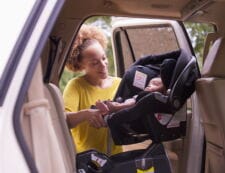The complicated truth behind car seat expiration dates

One journalist—and father—went searching for answers.
Table of Contents
Car seat safety is understandably an obsession for many parents. We want our children to be as safe as possible so we pay close attention to the recommendations of car seat manufacturers, pediatricians and experts. We make sure our child is in the safest seat and position for their size and when our car seats expire we dutifully dispose of them instead of passing them down to our younger children, friends or charities.
Every parent knows that car seats have expiration dates—but why do they? What studies and tests prompted manufacturers and safety advocates to make this rule? Could we be throwing away tons of perfectly good car seats?
Those are the questions that journalist Adam Minter set out to uncover while writing his book, “Secondhand: Travels in the New Global Garage Sale.” The answers he got didn’t satisfy him, and suggest that car seat expiration dates are more about increasing consumption than increasing protection.
Why and when do car seats expire?
A father himself, Minter was well aware of the fact that car seats have expiration dates when, in the course of reporting for Secondhand, he found himself at a used goods outlet in Tucson where secondhand car seats were being sent over the border to Mexico. Concerned that unsafe car seats may be putting children in other countries in danger, Minter decided to dig into the story—but what he uncovered was the opposite of what he thought he was chasing.
“There is no law prohibiting the sale of secondhand car seats post expiration or before,” Minter tells Motherly.
There is no law, Minter learned, because there is nothing proving that age alone makes a car seat unsafe.
Minter reached out to numerous car seat manufacturers and retailers expecting that they would be able to point him to a specific study or testing protocol used to determine when and why car seats expire. But he didn’t get a clear answer. Most companies did not reply or declined to comment.
He tells Motherly he was stunned that companies that use expiration dates on their products and marketing were unable to substantiate the claim that car seats degrade to the point of being unsafe after six years of existence.
Using a car seat past its expiration date
Neither Minter or Motherly could uncover a specific study that is the basis of this rationale. The United States Highway Transportation Safety Administration says there is no regulation prohibiting parents from using an expired car seat, but on the National Highway Traffic Safety Administration’s website, parents are advised “The seat has labels stating date of manufacture and model number. You need this information to find out if there is a recall on the car seat or if the seat is too old.”
Why car seats may have expiration dates
What could happen if a car seat is “too old?” Well, the National Highway Traffic Safety Administration‘s website does not go into detail, but the Government of Canada’s website does.
It states that:
“Manufacturers give an expiry or useful life date because over time:
- Frequent use and exposure to sunlight can damage and weaken plastic;
- Safe-use labels on the products fade or become hard to read;
- Instruction manuals have likely been lost;
- Food, cleaners, drinks and other materials that have been spilled or used on webbing, buckles, adjusters and other parts may prevent them from working safely;
- The history or condition of the car seat or booster seat becomes hard to check (was it in a crash, was it stored in a place or in a way that caused damage to parts, etc.?);
- Safety regulations and standards may have changed, so safer products may now be on the market; and
- Second or subsequent owners may not get product safety recall notices if problems arise.”
There is research to backup the first point. Exposure to sunlight can indeed damage plastic, but neither Minter nor Motherly were able to find any research that specifically looked at car seats, and how the plastic used in them might degrade when subjected to standard use in vehicles.
“We should actually have data available on the relative safety or unsafety of a secondhand car seat that, say sat in a car for 5 years in sunlight and one that’s totally new. And yet, if [manufacturers have] done those tests, for whatever reason, they’re not willing to disclose them,” Minter tells Motherly.
As for the rest of the Canadian list, the reasons listed do not apply to every car seat or situation. A family that is considering reusing their own car seat for a second or third child would know if it has ever been in a collision and how it was stored. The parents would know how often the car seat was cleaned and would either have the instruction manual or access to an online version.
As we’ve noted, government agencies in the United States and Canada do discourage parents from using expired car seats, and in these countries it is common for used car seats to be shredded or sent to the landfill, expired or not. But in some other countries, the use of used car seats is viewed as perfectly acceptable and is actually encouraged.
How other countries treat car seat expiration dates
Sweden has a remarkably low rate of child fatalities related to vehicles. The country is very seriously trying to reduce the rate to zero, and yet the director of traffic safety and sustainability at the Swedish Transport Administration, Maria Krafft, has publicly stated that used car seats are fine to use.
Krafft put Minter in contact with Professor Anders Kullgren of the Karolinska Institutet and the Chalmers University of Technology, who replied: “We have the same experience in Sweden. Manufacturers of child restraints (and other safety equipment such as bicycle and motorcycle helmets) tell their customers to buy a new product after a certain period of time, often relatively short. We can’t see any evidence to justify that from what we have seen in real-world crashes.”
Kullgren went on to say that he has access to car seats that are over 20 years old and has not seen any degradation in the plastic.
Bottom line: Car seat guidelines may not be black and white
This is at least according to Minter.
In an era when parents are extremely concerned about reducing consumption and carbon footprints, should so many car seats be thrown away, especially when there are parents struggling to afford car seats in the first place?
Perhaps it is time for parents to consider not throwing away or recycling or trading in their car seats, but passing them on to another parent. Minter was initially worried about the safety of children when he saw used American seats headed to Mexico, but now he is worried about the safety of children who would be safer in an inexpensive secondhand seat than none at all.
[Motherly has contacted government agencies, retailers and car seat manufacturers and will update our coverage when more information is available.]
A version of this post was originally published Dec. 5, 2019. It has been updated.


































